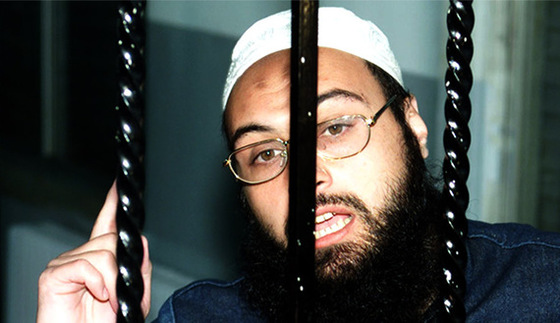A longtime jihadist who was born in the US and slated to take part in al Qaeda’s planned millennium attacks in Jordan has been rearrested by authorities.
Al Jazeera reported on its Arabic website earlier this month that Raed Hijazi, who spent more than a decade in prison, was detained once again by Jordanian authorities in November. The charges against Hijazi, who was identified as a leading member of the Salafi jihadist trend in Jordan, are not immediately clear. Hijazi’s son confirmed the arrest, which has been reported by other outlets as well.
According to the 9/11 Commission, Hijazi had sworn bayat (an oath of allegiance) to Osama bin Laden in 1999, at a time when he was plotting to carry out mass casualty attacks against several sites.
One of Al Jazeera‘s sources inside the Salafi jihadist trend, Sa’d al Hunayti, also said that Khadr Abu Hoshar had been warned by Jordanian security forces. Abu Hoshar has been one of Hijazi’s alleged accomplices since the 1990s. Jordanian officials reportedly told Abu Hoshar that any protests on behalf of his imprisoned comrades would lead to additional arrests.
The Jordanian government has also warned other members of the Salafi jihadist trend against supporting the mujahideen in Syria. Al Hunayti said that approximately 100 members of the Salafi jihadist trend had been jailed on charges of “heading to Syria for jihad.”
The 9/11 Commission Report on planned millennium attacks
The 9/11 Commission discussed the planned millennium attacks in Jordan at length in its final report. Jordanian authorities unraveled the plots beginning on Nov. 30, 1999, when they intercepted a telephone call from senior terrorist Abu Zubaydah to Abu Hoshar.
“The time for training is over,” Abu Zubaydah said.
The Jordanians suspected, according to the 9/11 Commission, “that this was a signal for Abu Hoshar to commence a terrorist operation.” Jordanian police then arrested 16 jihadists, including Abu Hoshar and Hijazi.
Hijazi was born in California, but lived in the Middle East for much of his childhood. After returning to California, according to the 9/11 Commission, Hijazi became an extremist and “then made his way to Abu Zubaydah’s Khaldan camp in Afghanistan, where he learned the fundamentals of guerrilla warfare.”
Sometime in the early to mid-1990s, Hijazi and his younger brother were recruited by Abu Hoshar “into a loosely knit plot to attack Jewish and American targets in Jordan.” But Abu Hoshar was arrested in Jordan in 1996, so Hijazi decided to move back to the US, becoming a cabdriver in Boston. The 9/11 Commission found that he sent some of the money he earned to his fellow plotters.
After Abu Hoshar’s release from prison, Hijazi “shuttled between Boston and Jordan gathering money and supplies.” The pair then worked to recruit jihadists in Jordan, Syria, and Turkey and “with Abu Zubaydah’s assistance, Abu Hoshar sent these recruits to Afghanistan for training.”
By late 1998, Abu Hoshar and Hijazi had settled on a plan to attack multiple sites frequented by Western tourists. “Hijazi and Abu Hoshar cased the intended targets and sent reports to Abu Zubaydah, who approved their plan,” according to the 9/11 Commission. Hijazi stockpiled the ingredients necessary to make the bombs their plan required.
Hijazi and Abu Hoshar contacted another alleged al Qaeda operative, Khalid Deek, in early 1999. They acquired a copy of the Encyclopedia of Jihad, a terrorist manual authored by Deek.
The 9/11 Commission reported what happened next. In June 1999, “with help from Deek, Abu Hoshar arranged with Abu Zubaydah for Hijazi and three others to go to Afghanistan for added training in explosives.”
Then, in late November 1999, “Hijazi reportedly swore before Abu Zubaydah the bayat to Bin Laden, committing himself to do anything Bin Laden ordered.”
The cell’s members were apprehended before they could move forward with their plan. Once in custody, the 9/11 Commission reported, Hijazi’s younger brother told authorities that their motto had been: “The season is coming, and bodies will pile up in sacks.”
Ties to Guantanamo detainees
The cell led by Abu Hoshar and Hijazi allegedly had ties to a current Guantanamo detainee named Haji Wali Mohammed. According to a leaked Joint Task Force Guantanamo (JTF-GTMO) threat assessment, Mohammed was identified as a high-level financier for the Taliban and al Qaeda. Mohammed, who is an Afghan, received assistance from Pakistan’s Inter-Services Intelligence Directorate (ISID), according to the JTF-GTMO file. [See LWJ report, The Gitmo Files: al Qaeda’s alleged primary financial manager.]
The JTF-GTMO file cites intelligence received from the Jordanians, who fingered Mohammed as a financier of the Aug. 7, 1998 embassy bombings in Kenya and Tanzania.
JTF-GTMO’s analysts also found that Mohammed had “financed an al Qaeda cell in Jordan led by [Khadr Abu Hoshar], which planned to conduct terrorists operations in conjunction with the millennium celebrations.”
There is another possible Guantanamo connection to Abu Hoshar and Hijazi. Al Jazeera reported that Usama Abu Kabir has been targeted in Jordan’s recent security operations. Abu Kabir, an ex-Guantanamo detainee, was arrested in 2009 and charged with plotting terrorist attacks against Israel.
According to Al Jazeera’s sources, however, Abu Kabir is one of the current members of the Salafi jihadist trend who are causing concern among Jordanian officials. If true, then obviously he was let out of prison at some point after his arrest.








